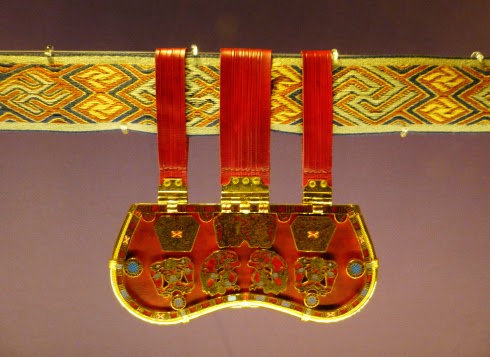Anglo-Saxon, early 7th century AD
From Mound 1, Sutton Hoo, Suffolk, England
British Museum
The lid was made to cover a leather pouch containing gold coins. It hung by three hinged straps from the waist belt, and was fastened by a gold buckle. The lid had totally decayed but was probably made of whalebone – a precious material in early Anglo-Saxon England. Seven gold, garnet cloisonné and millefiori glass plaques were set into it. These are made with a combination of very large garnets and small ones, deliberately used to pick out details of the imagery. This combination could link the purse-lid and the fine shoulder clasps, which were also found in the ship burial, to the workshop of a single master-craftsman. It is possible that he made the entire suite of gold and garnet fittings discovered in Mound 1 as a single commission.
 |
| Replica reconstruction of the purse-lid in the Sutton Hoo Museum, Sutton Hoo |
The plaques include twinned images of a bird-of-prey swooping on a duck-like bird, and a man standing heroically between two beasts. These images must have had deep significance for the Anglo-Saxons, but it is impossible for us to interpret them. The fierce creatures are perhaps a powerful evocation of strength and courage, qualities that a successful leader of men must possess. Strikingly similar images of a man between beasts are known from Scandinavia.

